- MN ABE Connect
- Archive
- A Picture is Worth…. Using Visuals in Math Class to Build Curiosity, Clarity, and Classroom Engagement!
 February 19, 2018
February 19, 2018
A Picture is Worth…. Using Visuals in Math Class to Build Curiosity, Clarity, and Classroom Engagement!
Abby Roza, Numeracy Advisory TeamWhat do you notice in the photo below?
What do you wonder?
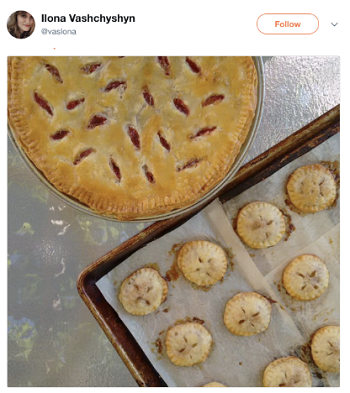
Perhaps:
How many little pies could I eat? How much big pie could I eat?
or
How many cherries are in a pie? How many cherries in these little pies?
In English Language Literacy instruction, many of us recognize the power of a well-used image. The right visual may be the opening to a lesson. It may create the opportunity where students connect what they know to what they are about to learn.
Used in a different moment, listening to a student describe or reason about an image can be the assessment, informing the teacher about what the student knows or is able to express. Images add interest and build engagement in our classrooms!
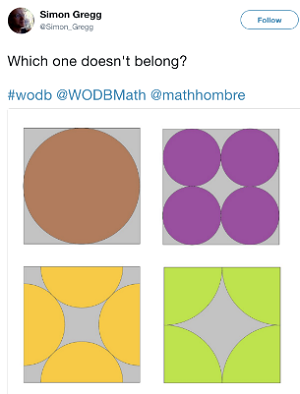 I was taught to use images in literacy instruction, and much more recently I was introduced to the power of images in my numeracy/math instruction. In numeracy instruction, most of us probably use images as a visual representation of numbers we are working with. But the right images at the right moment can do so much more.
I was taught to use images in literacy instruction, and much more recently I was introduced to the power of images in my numeracy/math instruction. In numeracy instruction, most of us probably use images as a visual representation of numbers we are working with. But the right images at the right moment can do so much more.
- Images might create a question in the learner’s mind, giving them a real application for a concept they are about to learn.
- It might spark a connection, curiosity, or an understanding about the structure or beauty behind a concept.
- A picture might engage a student who would feel anxiety or confusion if faced with the same concept in only words or numerals.
A few possible uses of images include:
- Notice & Wonder (see below)
- journal prompt or discussion as a “warm-up” or opening to a topic (e.g., introducing new numeracy content)
- journal prompt or discussion as an assessment
- an interactive bulletin board in the classroom in an area where students congregate for breaks, etc.
Whatever you choose to do, you might consider:
- Sentence Frames
- Quiet think time
- Think, Pair, Share
- Any vocabulary you’d like to offer or be ready to define as it comes up
What do you notice? What do you wonder?
The prompt “What do you notice? What do you wonder?” can be a great place to start (https://www.youtube.com/watch?v=a-Fth6sOaRA, Annie Fetter, The Math Forum).
Perhaps one of the images here will offer a numeracy connection for your classroom.

Images from: http://thingsorganizedneatly.tumblr.com/post/164410360759/submission-adam-hillman-cream-of-the-crop-2017

How might using rich visuals enhance numeracy for our students? It offers a very low floor in terms of both numeracy and language skills, and has a high ceiling: I’ve often been impressed by the content and complexity of students’ thinking when they are sharing what they noticed about the visual. It works well in a whole group class, one on one, or asynchronously (students who see the same teacher or use the same classroom but at different times might read and respond to each other’s responses on chart paper or post-it notes.). Students with different numeracy or literacy levels can engage in “noticings” and “wonderings” around the same image. The teacher can differentiate tasks from there.

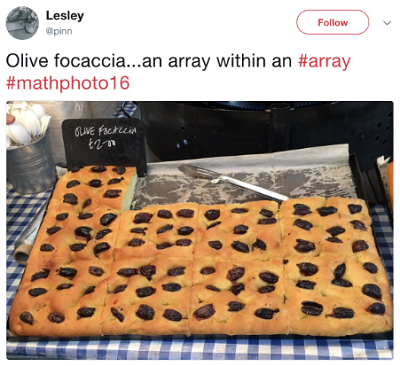
Use of images in this way can open access to the content without lowering the rigor of the content or the complexity of the application. The right high-interest image may engage the curiosity of student who, perhaps because of self concept or past experience, would not engage with a more “mathy” opening activity. It may spark the conversation where you can support the student in developing the vocabulary to explain a concept that makes sense to them.
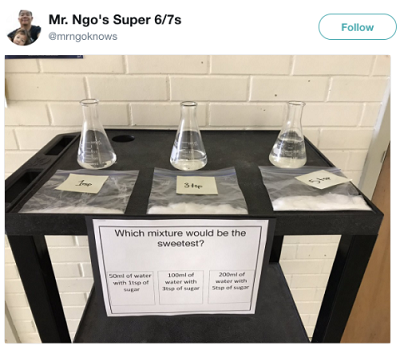

Noticing and wondering alone can be a great activity. Depending on the numeracy or literacy standards you’re targeting, and the richness of the image you chose, you could extend the use of the same image into other activities in the lesson. Links below will lead to more ideas.
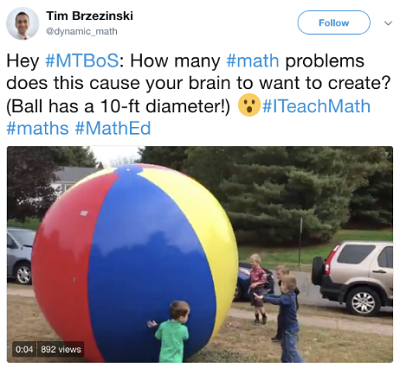

A response to this tweet points out that the Aargh! does something to the viewer’s engagement.
Was that true for you?
Further Resources
1. Twitter
None of these resources or strategies are my own. Each of these resources was shared by educators on Twitter! Twitter has become a prevalent and fun tool for sharing among math educators.
In less than 5 minutes, you can learn more about this powerful, free, easy professional development resource by clicking on the image below:
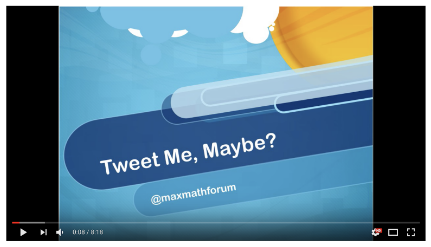
Unfortunately, the video is not closed captioned. It is not the same thing, but audio is transcribed here.
2. What do you Notice? What do you Wonder?
YouTube video
Annie Fetter, The Math Forum
3. Estimation 180
http://www.estimation180.com/
Using visuals to build numbers sense. Many teachers integrate this into a daily or weekly routine.
4. Visual Patterns
http://www.visualpatterns.org/
These patterns are representations of algebraic equations, even if this is beyond what your students are working on, describing them could be part of the language and numeracy foundations that prepare your students for algebra.
5. The Math Dial
In a speech to the 2016 National Council of Teachers of Mathematics (NCTM), Dan Meyer described teachers’ ability to adjust the “mathyness” in their room and how this impacts students’ access.
One-minute excerpt >>
More info >>
6. Which One Doesn’t Belong?
http://wodb.ca/
Ask students to discuss which image in a grouping does not fit in the group, and why. Because a sensible argument can be made for all of the options, rich mathematical discussion is possible.
7. Sara VanDerWerf blog
This Minnesota teacher has presented and written about how she is using visuals, picture and color to engage students in her math classes. These portions of her blog represent one small part of the ideas I gained from her presentation:
8. Numeracy Resource Library – ATLAS website, under RESOURCES tab
The Numeracy resource library houses a wealth of resources vetted by Minnesota ABE numeracy professionals and organized around the effective numeracy practices that form the foundation of MNI (MN Numeracy Initiative), as well as the math standards outlined in the College and Career Readiness Standards for Adult Education (CCRS).
Newsletter Signup
Get MN ABE Connect—the official source for ABE events, activities, and resources!
Sign UpArticle Categories
- ABE Foundations/Staff Onboarding
- ACES/Transitions
- Adult Career Pathways
- Assessment
- CCR Standards
- Citizenship
- COVID-19
- Cultural Competency
- Digital Literacy/Northstar
- Disabilities
- Distance Learning/Education
- ELA
- Equity/Inclusion
- ESL
- HSE/Adult Diploma
- Listening
- Math/Numeracy
- Mental Health
- Minnesota ABE
- One-Room Schoolhouse/Multilevel
- Professional Development
- Program Management
- Reading
- Remote Instruction
- Science
- Social Studies
- Speaking/Conversation
- Support Services
- Teaching Strategies
- Technology
- Uncategorized
- Volunteers/Tutors
- Writing